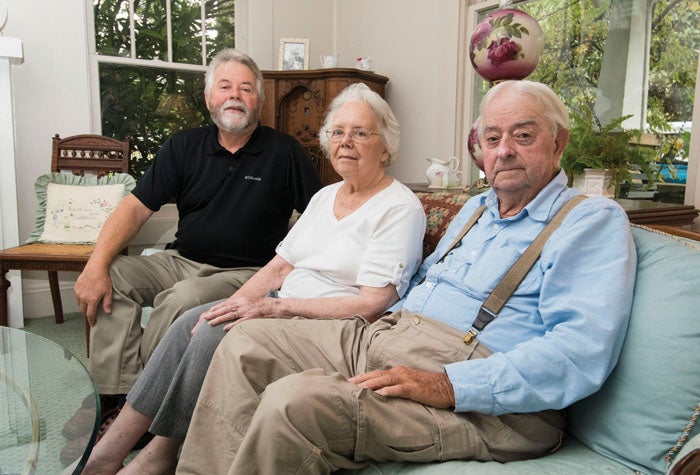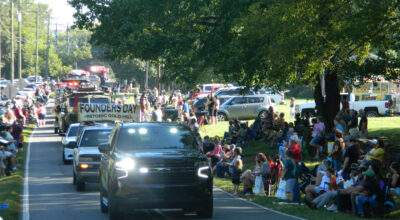A World War II airman is found: Capt. Russell is coming home
Published 12:00 am Sunday, September 17, 2017

- JON C. LAKEY / SALISBURY POST Ernest Lamar Yelton, Patsy Yelton and John Yelton at home in Gold Hill. The Family of Capt. Lamar Russell of Gold Hill recently received notification that some some remains was recovered from a remote mountain top in New Guinea. Russell, while serving in the US Army Air Force, was on a B25 Mitchell Bomber on a ferrying mission that crashed in bad weather on February 1st 1944. A funeral service for Captain Russell will be held at Gold Hill UMC on September 24th with remains to be buried at the church cemetery. Thursday, September 14, 2017, in Gold Hill, N.C.
GOLD HILL — The world seemed to stop for a moment when Jim Bell reached into his briefcase and pulled out the bent but still legible dog tags of Capt. Lamar Shafer Russell.
If ever there was closure, this was it. Those dog tags had come a long way — from a jungle mountainside in New Guinea where the B25 Russell had been a passenger in crashed more than 73 years ago, killing all 11 men on board.
Patsy Russell Yelton was 13 then. Now she’s 86. The dog tags Bell laid out before her really were a peace offering of sorts. After all of these years, they finally set her mind at peace about her oldest brother, lost ages ago.
“It was amazing,” she says. “It was really him.”
Earlier this summer, Bell came to Patsy and John Yelton’s home in his role as an identifications liaison with the Past Conflict Repatriations Branch of the U.S. Army.
Bell works out of the Casualty & Mortuary Affairs Operation Center at Fort Knox, Ky., and he brought with him a softbound book detailing the Army’s efforts over the years to communicate with the family while also trying to find and identify any remains of Russell and bring him back home.
In recent years, those efforts were successful, thanks in part to DNA testing.
Bell told the Yeltons the Army treats the return of fallen soldiers from past conflicts — sometimes those even beyond World War II — the same as they would a soldier killed in Afghanistan last week.
“It’s amazing what they’re doing to find boys all over the world,” John Yelton says.
By matching DNA samples taken in 2014 from Patsy and her son, Ernest Lamar Yelton — who was named in honor of both brothers Patsy lost in World War II — the Army was able to identify pieces of Lamar Russell at the wreckage site in New Guinea.
It is these parts — a left humerus, a right and left clavicle, a left scapula and a couple of cervical vertebrae — which will be flown from Hawaii to Charlotte on Friday, then receive a military, law enforcement and Patriot Guard escort to the Powles Staton Funeral Home in Rockwell.
The Yelton family will be in Charlotte to meet the 12:30 p.m. flight from Hawaii, and Patsy will be able to return with her brother’s flag-draped casket.
A funeral is planned for 2:30 p.m. next Sunday (Sept. 24) at Gold Hill United Methodist Church. (The family will greet people from 1:30-2:30 p.m. prior to the service.)
Had he lived, Capt. Russell would be 102 today. He planned on becoming a doctor after the war.
The Rev. Beverly Mauldin, pastor, and Dr. Ken Clapp, chaplain of Catawba College, will officiate the Sunday service. Russell had been a 1939 graduate of Catawba, and the little Methodist church in Gold Hill was his home church.
The burial of Russell will follow at the Gold Hill Cemetery, which John Yelton has been maintaining for the past 20-plus years. It’s about a half-mile on St. Stephens Church Road from the Methodist church.
A family plot at the cemetery includes the grave sites of Patsy’s parents, Raymond and Beulah. Her brother Ernest “Hink” Russell, a Marine, also is buried there. Ernest was killed in action on Saipan in the Marianas on June 15, 1944, only four months after Lamar went missing.
There’s already a marker for Lamar at the cemetery that was provided by the Army decades ago at Patsy’s request. She says the funeral service is another kind of closure for her and her family.
“It feels good,” she says. “… Everybody I see says they’re going to be coming.”
Patsy corresponded with Lamar during the war, even though there was a 14-year age difference between the two. “That’s his bedroom right there,” she says, nodding toward a door off the living room.
She still has a letter from Lamar to her parents that arrived in Gold Hill Feb. 1, 1944, the day his plane crashed and disappeared.
Lamar had contracted malaria in New Guinea, and though his condition reportedly had improved, he was going on sick leave and was a passenger on that B25 Mitchell bomber going from Dobodura to Port Moresby.
From what the family knows after all these years, bad weather forced the pilot to turn around that day, Feb. 1, 1944, and try to return to Dobodura. The base lost contact with the bomber around 7:30 a.m.
One theory about the crash, Lamar Yelton said, was that the crew was using maps that incorrectly put the highest elevation in the Owen Stanley mountain range at 8,500 feet. The plane was flying at 10,500 feet and probably crashed into the mountain peak known as Kenevi, which is 11,000 feet high.
The wreckage was located years later on the side of that mountain.
Beulah and John Russell received a telegram Feb. 8 notifying them of Lamar’s disappearance. Someone with Kirk’s taxi service in Salisbury drove the telegram to her father, who was working in Mooresville that day, Patsy says.
A month later, March 8, the Russells received a letter from Lamar’s commanding officer with more official confirmation of the lost plane and a deeper explanation:
“It is with regret,” the letter said, “that I inform you that your son, Lamar, has been missing somewhere in the South Pacific area since 1 Feb. 1944. He was a passenger is an airplane participating in a routine flight over friendly territory which has been unreported since it took off from our home airdrome.
“A search which was immediately instituted has unfortunately proven unsuccessful, but the search is being continued. Since the route of the aircraft is one regularly flown, the possibility of the aircraft being located is very probable and we have not given up hope.”
But it wouldn’t be until 1961 until the wreckage was found — by chance — by a patrol from the Royal Australian Air Force looking for a missing civilian plane.
The RAAF and U.S. Army conducted a joint search and recovery mission, and it wasn’t easy. It took two American servicemen, two members of the RAAF, four native patrolmen and 60 carriers hiking several days through heavy jungle to reach the crash site.
A report on that 1961 mission said, “Progress was impeded by heavy rains that caused landslides which hampered trail movement; insects, leeches, mosquitos and ticks that beset the members of the patrol; and dense undergrowth, as well as natives who deserted the patrol because of their superstitious belief that spirit of their ancestors inhabited certain areas.”
The 1961 team found some human remains at the crash site and identification tags, a bracelet and a graduation ring that could be linked to four of the men, though not Russell. The violence of the crash and erosion that had occurred made the remains impossible to connect to any of the 11 men, and there was no DNA testing at the time.
Those remains ended up being placed in two caskets and were shipped to the National Cemetery in Arlington, Va., where military services were held for the 11 men lost.
John Russell had died by then, but Beulah Russell was able to make the car trip to Arlington.
Others attending were John and Patsy Yelton and their children, Lamar and Patricia; Lamar Russell’s aunts, Dora Atkins and Grace Shafer, both of Gold Hill; and cousin Frank Shafer, a physician in Salisbury.
John Yelton remembers how the family met snow in Virginia on their way to the cemetery. The service held included Catholic, Protestant and Jewish rites and a memorial stone sits in Arlington National Cemetery with the names of all 11.
Lamar Yelton says some 11 war planes were actually found crashed on that New Guinea mountain over the years.
Patsy Yelton says her mother for years had never given up the hope her son was lost in the jungle and that maybe someday he would walk through the front door of her Gold Hill home.
Patsy acknowledges she possessed some of the same feelings.
In 2013, Bell, a former tank commander, called Patsy and Lamar and told them the Joint POW/MIA Accounting Command had in its possession more remains from a more recent third-party search of the crash site in New Guinea.
Bell, a retired tank commander, asked for their permission to send them a swab kit to retrieve samples of their DNA, which might be compared to what was found. It was sometime last year, that Bell called again and said some remains had positively been identified as belonging to Lamar Russell.
The Army’s official evidence report is dated May 4 of this year, and Bell visited Patsy and Lamar in July. He was accompanied by Maj. Diana Stumpf of Asheville, who has taken over all the Army responsibilities leading to Lamar Russell’s delivery and interment.
A retired pastmistress of Gold Hill, Patsy has lived in her parents’ home place her entire life.
She remembers how Lamar fashioned his own little golf course in the side yard. Lamar Yelton, who lives close by, said he still has his late uncle’s golf clubs.
John Yelton says Lamar Russell planted a couple of the big cedar trees in the yard of the Russell home place.
Lamar Russell had attended Rockwell School before moving to Salisbury so he could attend three years at Boyden High and four years at Catawba College. He joined the Army Air Corps in 1940.
He trained at Fort Worth, Texas, and Denver, Colorado, before going overseas as a second lieutenant in January 1942. He was stationed first in Australia, then New Guinea, and he made a name for himself as part of the photographic section in his bombardment group.
Russell proved to be a pioneer in the development of a camera mount for taking minimum altitude oblique photographs. It solved problems connected with taking detailed pictures from aircraft flying at high speed and low altitude.
For his work, Gen. Douglas MacArthur, commander in chief of the Southwest Pacific forces, conferred on him the Legion of Merit award in December 1943, less than two months before he was lost in that crash.
His family says Lamar also was up for a promotion from captain to major. The Miller-Russell American Legion Post is named in part for the Russell boys, Lamar and Ernest, who were both lost in 1944.
That year was a horrible one for the Russell family. Dog tags she can hold, a casket she can see, a service she can participate in — all these things help with the healing, even after all these years.
As Patsy Yelton will tell you, it really is him.
Contact Mark Wineka at 704-797-4263 or mark.wineka@salisburypost.com.



